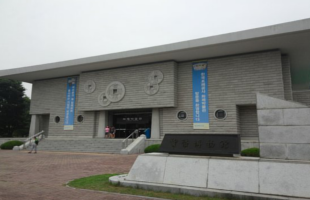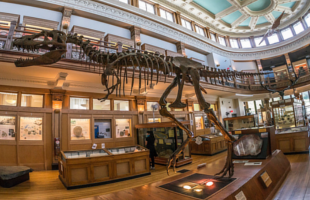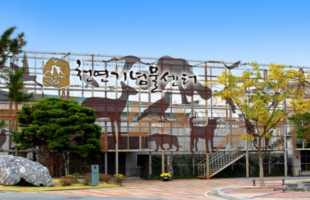 The Currency Museum of Korea is the first museum in Korea to be dedicated solely to modern and ancient currencies. The museum is operated by the Mint Corporation of Korea as part of its non-profit public services and is open to visitors free of charge with a view of increasing public knowledge of the nation’s currency. The museum features a total of 120,000 pieces. |
 The Geological Museum located in Yuseong-gu, Daejeon-si, is the nation’s first comprehensive museum dedicated to geology. The museum (est. 2001) boasts an architectural design inspired by the breastplate of a Stegosaurus and is divided into a main hall, 2 exhibition rooms, a show room, an outdoor exhibition area, and a special exhibition hall. |
|
 Clayarch Gimhae Museum aims to play a leading role in the development of architectural ceramics, which are now spreading across the globe. |
 Gyeongnam Art Museum is an art museum in Changwon, South Korea. Initial planning began in 1998, and the museum opened on June 23, 2004. |
 Korea Naval Academy Museum, It was established by the Korea Naval Authorities in order to educate naval soldiers and cadets for … |
 The Korea National Maritime Museum is a Korean maritime museum and the third largest museum in the Republic of Korea. |
 Trick Eye Museum is a unique museum featuring large-scale, touchable works of illusionistic “3D” art & photo ops galore. |
 Daegu Art Museum, a municipal art museum inaugurated in May 2011 and supported by the Daegu Municipal Government. |
 Daegu Textile Complex (DTC) is the one and only textile museum in Korea, which has been established to share the history of local textile and FASHION industry and the visions. |
 The Uijae Museum of Korean Art was established in memory of the famous Korean artist Heo Baekryeon. the museum wasn’t officially opened until November 17th, 2001. |
 The Gwangju Museum of Art was established on August 1st, 1992 and has been under the management of the Gwangju Biennale Committee ever since the opening of the Biennale Hall in 1995. |
 The Gwangju National Museum was established at Maegok-dong of Jeollanam-do on Dec. 6, 1978 after Korea’s liberation from Japan in 1945. It has a collection of more than 40,000 pieces and has Prehistoric Gallery, Sinan Marine Relics Gallery, Pottery Gallery, Buddhist Art Gallery, and Planned Display Gallery. |
 Ganghwa History Museum opened in 2010, and is located inside Ganghwa Dolmen Park, which was designated as UNESCO World Heritage Historic Site No. 137. The museum aims to exhibit, preserve and educate about the history and culture of Ganghwa from prehistoric ages to modern times based on artifacts from the area. |
 In 1999, the area of Geomdan carried out the excavation for cultural relics. As a result of the excavation, various relics and remains from the Bronze Age and Old Stone Age to the Joseon Period were found and as a result the Geomdan Prehistory Museum was built on November 27, 2008. |
 War Memorial of Korea is located in Yongsan-dong, Yongsan-gu, Seoul, South Korea. It opened in 1994 on the former site of the army headquarters to exhibit and memorialize the military history of Korea. |
 The National Museum of Korea is the flagship museum of Korean history and art in South Korea and is the cultural organization that represents Korea. |
 The Natural Heritage Center was established to help the locals to learn about the value and importance of natural heritages through exhibitions and education on the methodical study of natural heritages and national monuments. Fossils(i.e. dinosaurs’ eggs and footprint), animal specimens (eagles, asiatic black bear), botanical specimens (i.e. jondo-ri pine tree) and many other natural heritages are exhibited. |
 |
- South Korea -
|  |
|||
Information about South Korea: South Korea is a sovereign state in East Asia, constituting the southern part of the Korean Peninsula. Highly urbanized at 92%, South Koreans lead a distinctive urban lifestyle; half of them live in high-rises concentrated in the Seoul Capital Area with 25 million residents and the world’s sixth leading global city with the fourth largest economy and seventh most sustainable city in the world.. Read More...

 Heritages and Museums
Heritages and Museums








